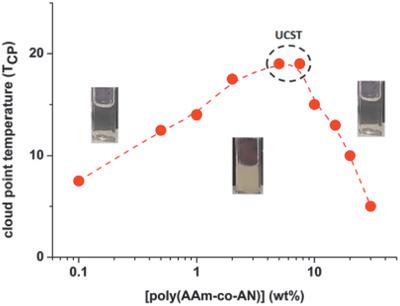当前位置:
X-MOL 学术
›
Macromol. Rapid Commun.
›
论文详情
Our official English website, www.x-mol.net, welcomes your
feedback! (Note: you will need to create a separate account there.)
Synthesis of Thermoresponsive Copolymers with Tunable UCST-Type Phase Transition Using Aqueous Photo-RAFT Polymerization.
Macromolecular Rapid Communications ( IF 4.2 ) Pub Date : 2020-03-18 , DOI: 10.1002/marc.202000058 Pattida Lertturongchai 1 , Mohamed I A Ibrahim 2 , Alain Durand 2 , Panya Sunintaboon 1 , Khalid Ferji 2
Macromolecular Rapid Communications ( IF 4.2 ) Pub Date : 2020-03-18 , DOI: 10.1002/marc.202000058 Pattida Lertturongchai 1 , Mohamed I A Ibrahim 2 , Alain Durand 2 , Panya Sunintaboon 1 , Khalid Ferji 2
Affiliation

|
Currently, the phase transition of aqueous binary systems containing thermoresponsive (co)polymers, and exhibiting upper critical solution temperature (UCST), is exclusively investigated in dilute solutions, which can limit the knowledge of their UCST-type phase transition. Herein, a photo-RAFT polymerization approach, using acrylamide (AAm) and acrylonitrile (AN) as monomer models, is used to prepare well-controlled poly(AAm-co-AN) copolymers "in situ" in highly concentrated dispersions (60 wt%). The impact of the copolymer concentration and the chemical composition (as a variation of AN fraction in the copolymers) on the cloud point temperature (TCP ) are investigated using turbidity measurements. Importantly, the results show that upon increasing the polymer concentration, a sharp increase of TCP up to a maximum point is observed, representing the UCST, before the decrease of TCP at higher polymer concentrations. Finally, a model equation is developed to fit the UCST values of poly(AAm-co-AN), which can be useful to design new poly(AAm-co-AN) copolymers with a desired UCST for a specific application.
中文翻译:

使用水-RAFT聚合合成具有可调UCST型相变的热敏共聚物。
当前,仅在稀溶液中研究了含有热敏性(共)聚合物的二元水性体系的相变,并表现出较高的临界溶液温度(UCST),这可能限制了他们对UCST型相变的认识。在本文中,使用丙烯酰胺(AAm)和丙烯腈(AN)作为单体模型的光-RAFT聚合方法用于在高浓度分散体(60 wt%)中“原位”制备控制良好的聚(AAm-co-AN)共聚物。 %)。使用浊度测量研究了共聚物浓度和化学组成(作为共聚物中AN分数的变化)对浊点温度(TCP)的影响。重要的是,结果表明,随着聚合物浓度的增加,TCP会急剧增加直至最高点,在较高的聚合物浓度下TCP降低之前代表UCST。最后,开发了一个模型方程以拟合聚(AAm-co-AN)的UCST值,这对于设计具有特定应用所需的UCST的新型聚(AAm-co-AN)共聚物很有用。
更新日期:2020-03-18
中文翻译:

使用水-RAFT聚合合成具有可调UCST型相变的热敏共聚物。
当前,仅在稀溶液中研究了含有热敏性(共)聚合物的二元水性体系的相变,并表现出较高的临界溶液温度(UCST),这可能限制了他们对UCST型相变的认识。在本文中,使用丙烯酰胺(AAm)和丙烯腈(AN)作为单体模型的光-RAFT聚合方法用于在高浓度分散体(60 wt%)中“原位”制备控制良好的聚(AAm-co-AN)共聚物。 %)。使用浊度测量研究了共聚物浓度和化学组成(作为共聚物中AN分数的变化)对浊点温度(TCP)的影响。重要的是,结果表明,随着聚合物浓度的增加,TCP会急剧增加直至最高点,在较高的聚合物浓度下TCP降低之前代表UCST。最后,开发了一个模型方程以拟合聚(AAm-co-AN)的UCST值,这对于设计具有特定应用所需的UCST的新型聚(AAm-co-AN)共聚物很有用。











































 京公网安备 11010802027423号
京公网安备 11010802027423号